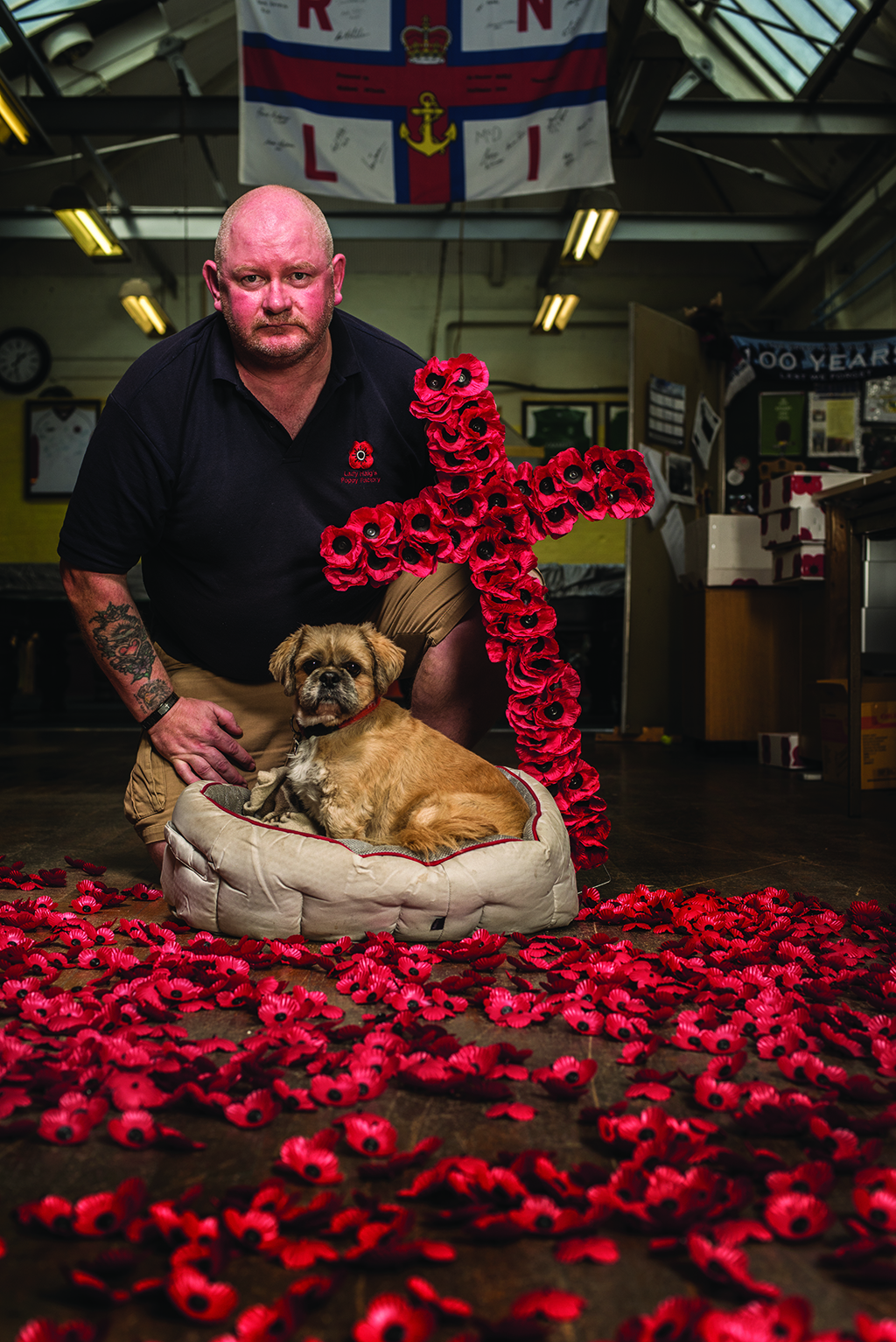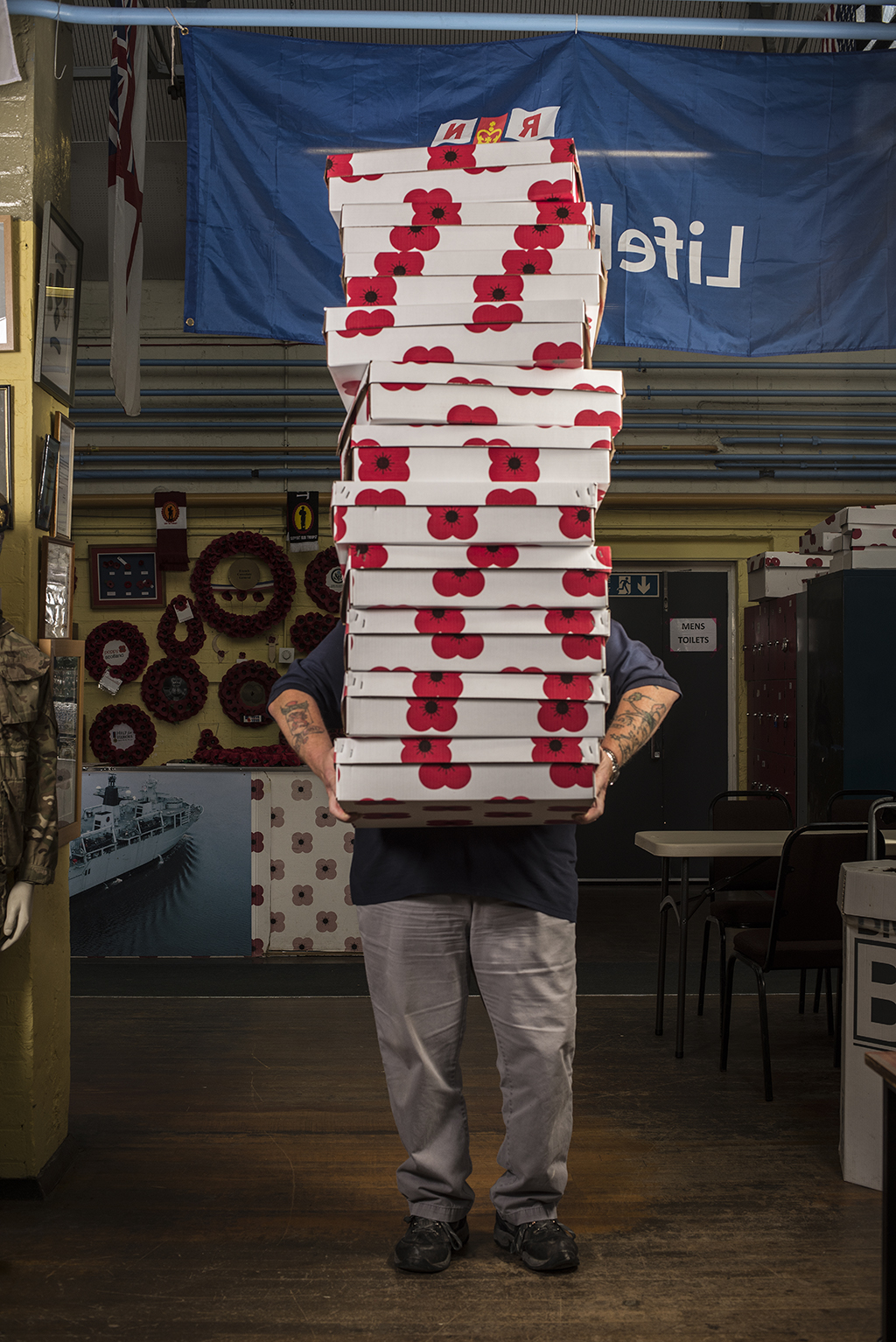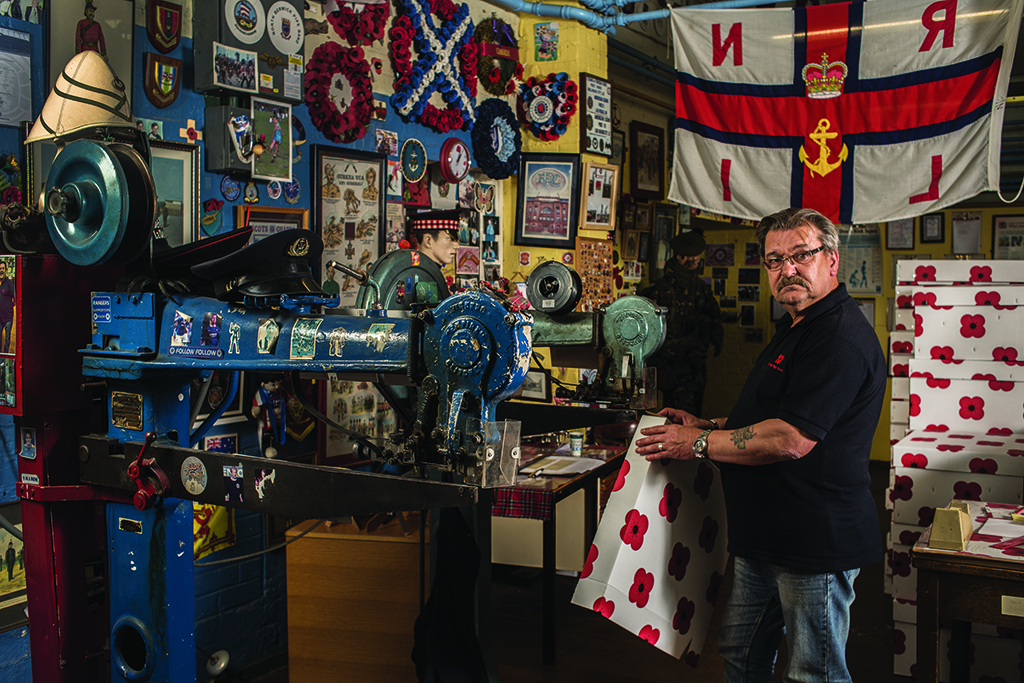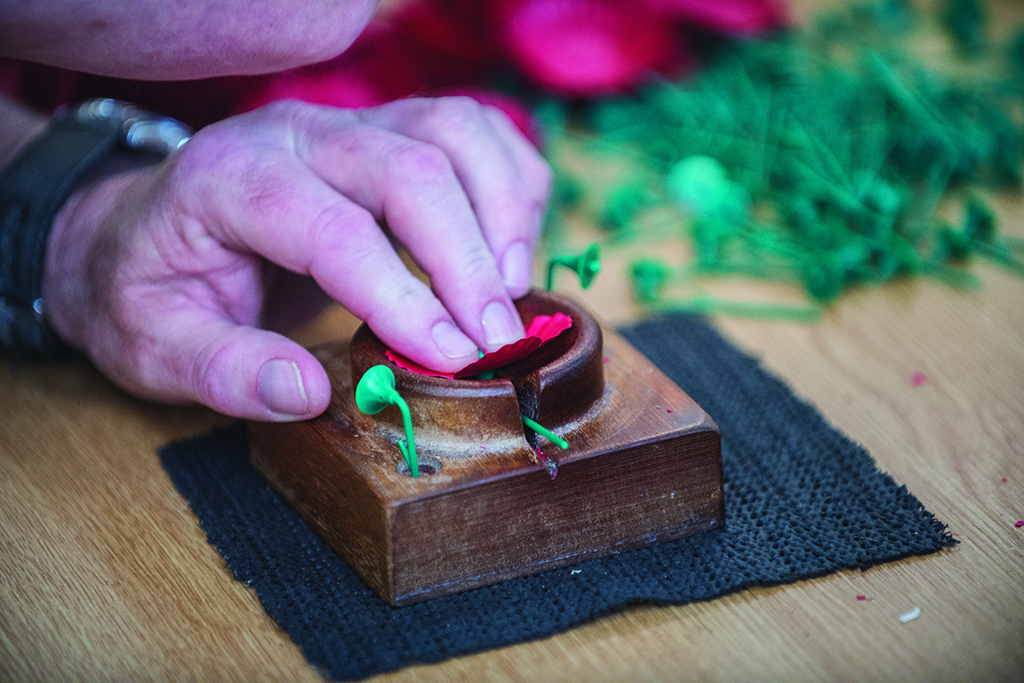
Lest We Forget our war heroes and the poppy makers
When visiting Lady Haig’s Poppy Factory in Edinburgh a few weeks before Remembrance Day, it would be easy to expect a flurry of activity with last minute poppies being assembled and the finishing touches being added to wreaths.
But the poppy makers are surprisingly laid back having finished preparations for this year and already crafting poppies for next year.
The period from the beginning of September through to the end of November is a special time at the factory as it is the main period for school children to visit. The workers at Lady Haig’s are all ex-servicemen who have some form of disability, either due to what happened to them whilst serving or from events that took place after.
Every year the team produce around 5.3 million poppies along with 12,000 wreaths. The poppy was established as the symbol of remembrance following the end of the First World War.

David Graham and dog Gizmo (Photo: Angus Blackburn)
Lt Col John McCrae, a Canadian born to Scottish parents, joined the Canadian Medical Corps when war broke out in 1914. In May 1915 he found himself based at a dressing station treating soldiers injured in the second battle of Ypres. The loss of life during the battle was immense with over 10,000 Canadian soldiers losing their lives in the first week of the battle alone.
It was here, after attending the funeral of one of his friends, that McCrae wrote his iconic poem In Flanders Fields.
In Flanders fields the poppies grow
Between the crosses, row on row,
That mark our place; and in the sky
The larks, still bravely singing, fly
Scarce heard amid the guns below.
We are the Dead. Short days ago
We lived, felt dawn, saw sunset glow,
Loved and were loved, and now we lie
In Flanders fields.
Take up our quarrel with the foe:
To you from failing hands we throw
The torch; be yours to hold it high.
If ye break faith with us who die
We shall not sleep, though poppies grow
In Flanders fields.
An American teacher Moina Belle Michael, later known as the ‘Poppy Lady’, read the poem and, moved by his words, began selling silk poppies shortly after the end of the war to raise funds for disabled veterans. She advocated for the flower to be worn in November as a sign of remembrance for those who had lost their lives or been injured in the war.
Field Marshall Earl Haig, who had been Commander in Chief on the Western Front from 1915 onwards, was in the process of founding the Royal British Legion when he learnt about the poppy being used in the act of remembrance and quickly adopted it as the symbol for the legion as well as a way to raise funds for injured servicemen.
A factory was set up in London to produce poppies and shortly afterward Haig’s wife, Lady Haig, set up a Scottish facility in the grounds of Whitefoord House on the Royal Mile. Along with her team of seven, she successfully held the first Scottish Poppy Appeal in 1926.

Poppies are boxed and ready to go. (Photo: Angus Blackburn)
The Scottish Poppy Appeal has been running ever since and continues to raise funds to support ex-Service men, women and their dependents in Scotland.
The Lady Haig Poppy Factory moved to its current location on Warriston Road in 1965 and now employs around 45 men.
The poppies are still hand assembled as a way of employing more ex-servicemen who may otherwise struggle to find work due to their disabilities.
The flowers assembled in the factory have four crimped petals and no leaf whilst those produced in England have two petals and a single green leaf.
Factory tour guide Tam McPhillips, a former radio operator in the Royal Signals, laughs. ‘It’s all down to cost,’ he says. ‘If we were to put a leaf on every single poppy it would cost an extra £15,000 and quite simply, we think that money is better spent on providing support to Scotland’s Armed Forces community. Plus, we quite like being different to England.’

Jim Pattie was formerly in the RAF and now works as a full-time poppy maker at Lady Haig’s Poppy Factory (Photo: Angus Blackburn)
Once the poppies are assembled they are distributed across the country to around 10,000 volunteers and collectors who take to the streets to ask for donations in return for the flowers.
A familiar face around Edinburgh is 78-year-old poppy seller Margaret Hughes who takes to the Royal Mile year after year to sell poppies and raise funds. ‘My husband was a Royal Marine for 23 years and would sell poppies on the streets of Edinburgh every year without fail, so when he died I took over.’
As well as manufacturing poppies to be sold, the factory takes on an important role as a living museum educating over 2,000 primary school children each year about the poppy. ‘By visiting the factory, the kids learn about what it means to wear a poppy from guys who have served,’ says former Gordon Highlander Gerry Lindsay.
‘I served in Northern Ireland several times and it’s not taught in schools, it’s like a forgotten war and it shouldn’t be that way. You need to keep the memory of these conflicts going and the poppy is a way to do that.’
Tam adds: ‘It’s also important to reiterate what it actually means to wear a poppy. It’s not about showing support for war. Governments go to war; the soldiers, sailors and airmen follow orders. Wearing a poppy is a mark of respect and remembrance for these people, and the many who died or were injured whilst serving their country.’

Making poppies at the Lady Haig Poppy Factory in Edinburgh (Photo: Angus Blackburn
Although peaking in November, the act of remembrance is important for the men of Lady Haig all year round. Kenny Duffy, who formerly served in the Royal Navy, laid a wreath at the Legion Scotland Service of Commemoration marking the 35th anniversary of the Falklands Conflict and the tenth Anniversary of the end of operations in Northern Ireland last July at the Canongate Kirk in Edinburgh.
‘Whilst I was serving in the Falklands, I remember I was up on the bridge of HMS Antrim watching as the HMS Antelope was blown up. Laying a wreath was very emotional and it brought back a lot of sad memories.’
Adjusting back into civilian life has been difficult for a number of the poppy makers.
‘When you come out the army you realise civilians don’t have the same sense of humour as forces guys do,’ says Gerry. ‘But working in here, we’re all ex forces so there’s plenty of banter.’
The atmosphere in the factory is unique. ‘It’s good to have a place like this which understands people with disabilities,’ adds ex-soldier David Graham. ‘A big plus for me is that I get to bring my therapy dog Gizmo in with me. I was a dog handler for a while before I left the army so it’s good to be around dogs again, although Gizmo is about as far as you could get from the
dogs I dealt with in the army.’
This feature was originally published in October 2017.
TAGS

